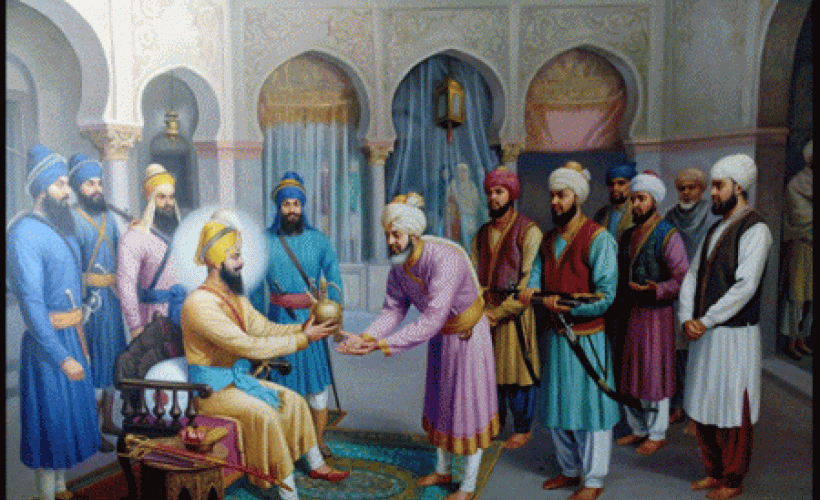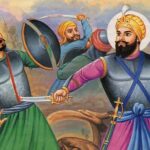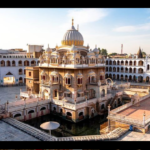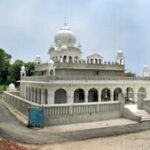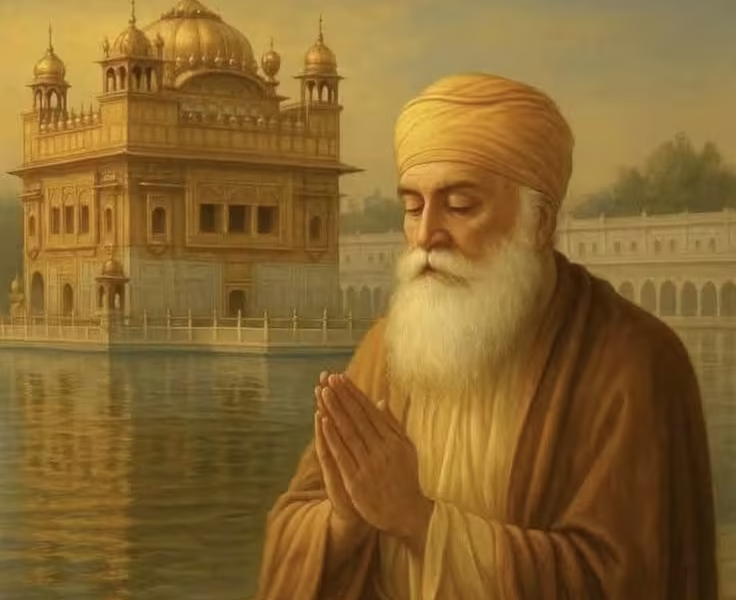SHRI GURUDWARA KHAN GANI NABI KHAN is located in the town of Machiwara in the district of Ludhiana. Guru Gobind Singh once crossed this holy area of Machiwara Sahib on his way from Gulabe & Punjabe’s home. Even though Gani Khan and his brother Nabi Khan were well aware of the danger that Guru Gobind Singh was in, their respect for the Sikh Guru was such that they risked certain death if found and traveled to meet with him, pleading with him to come to the safety of their home.
They noted that there were far too many informers prowling around, so they proposed that the Guru wear blue garments, as it would be easier and far safer for them to travel. As a result, a dyer was required. When the dyer arrived, Guru ji asked him to re-color his clothes blue, a hue associated with Sufi Sants at the time. The dye takes three days to mature in the dyer.
The dyer then told the Guru that he could do whatever he wanted, but that the clothes could only be dyed once a matti (a huge clay pot) was fully prepared, which would take three days once the dye was applied. The Guru informed the tradesman that he had already prepared a matti; when the dyer entered the next room and viewed it, he was astounded to see the matti already boiling with the appropriate dye in the water.
The dyer, now certain that the Guru was a genuine ‘Hermit of God,’ knew that he should request a favor from him. The dyer stood with his palms pressed together after coloring the robes and offering them at the Guru’s feet. Guru Ji handed the man some coins, but the dyer refused to accept payment. Guru Ji then asked him what he want. The dyer requested his blessing to have a child. Then added a second plea asking, “since I am unable to earn enough for a living and am not able to pay off the debt I owe for the dye I use, kindly bless me.
The dyer’s requests are granted by the Guru.
“The matti in which you have dyed my clothing will never again require any coloring to be applied to it,” Guru Gobind Singh answered. Simply dip your cloth in it, and whatever color you believe in your heart will become the color of the cloth. Keep the matti hidden and don’t tell anyone about it. Gurdwara Chaubara sahib exists in the area where the dyer’s wish was granted and he was made so joyful and pleased. It is around 500 yards from Gurdwara Ghani Khan Nabi Khan. Even now, you can visit Gurdwara Chaubara sahib and view the Matti sahib.
Gani and Nabi Khan’s Request
Khan Gani Nabi Khan requested that the Guru accept their service even though they did not have any children, to which the Guru replied that your service had already been accepted and that whatever blessings were provided are written in the Guru Hukamnama. The Guru remained here for two days and two nights. From here, the Guru, Gani Khan, Nabi Khan, Bhai Daya Singh Ji, Bhai Dharam Singh Ji, and Bhai Maan Singh Ji rode in a Palki to Gurdwara Kirpan Bhet Sahib, which is about 2 kilometers distant, passing via Gurdwara Katana Sahib and village Rampura Kanech on their way to Alamgir.
Machhiwara was named after the fish machhi (ground). Machhiwara was once a little fishing village on the banks of the Sutlej River. The river’s flow has changed throughout time, and it now runs 13 kilometers away from Machhiwara. Machhiwara was surrounded by deep woodland, which had been cut over time to create a place for farming.
Machhiwara Battle
Humayun was the second Mughal Emperor, ruling over what is now Afghanistan, Pakistan, and parts of northern India from 1531 to 1540, and then again from 1555 to 1556. He, like his father, lost his kingdom early, but reclaimed it with the help of Persia’s Safavid dynasty, along with extra land.
Humayun conquered Lahore in February 1555, as he struggled to reclaim his control in India. Dipalpur was seized by another detachment of his army. The Mughal army then took over Jalandhar, and their advanced division marched towards Sirhind. Sikandar Shah Suri sent a troop of 30,000 horsemen with Naseeb Khan and Tatar Khan, but they were defeated in a battle at Machhiwara by Humayun’s Mughal army. On May 15, 1555, Humayun and the Afghans fought a battle.
Udho Singh Ghorewaha, Rana
Rana Udho Singh Ghorewaha inherited Machhiwara and the surrounding regions after receiving Rahon as a Jagir from Emperor Akbar in exchange for his capture of the rebel General Bairam Khan. Ghorewaha Rajputs owned this village and several others in the vicinity.
History of the Sikhs
When Emperor Aurangzeb’s troops invaded Chamkaur Sahib, Sri Guru Gobind Singh Ji successfully resisted and sneaked away into the Machhiwara jungles. The Mughal forces pursued.
Today, there are four Historic Sikh Gurdwaras that commemorate what happened when Sri Guru Gobind Singh Ji, who had just lost two of his sons, traveled to Machhiwara’s woods.
Gurdwara Sri Charan Kamal Sahib is a Hindu saint.
Gurdwara Sri Charan Kanwal Sahib commemorates the garden where Sri Guru Gobind Singh Ji initially stopped to sip water and rest. According to legend, this is also where Bhai Daya Singh, Bhai Dharam Singh, and Bhai Mani Singh reunited with Guru Gobind Singh (after a hard journey through the thorny jungle of Machhiwara). The well from which Guru Gobind Singh drank remains, and water is made available to visiting Sangats. The Jand tree, under which Guru Ji reclined, is located to the left of the Gurdwara Sahib. The Guru sang the Shabad ‘Mitra Pyare Nu’ here.
This shrine’s core edifice comprises a square hall on the ground floor and a square sanctuary in the center, where Guru Granth Sahib is situated. In the second story, the domed pavilion over the sanctum houses a colossal image of Guru Gobind Singh in a resting stance. On this floor, there are also ornamental domed pavilions, square at the corners and rectangular at the wall midpoints.
